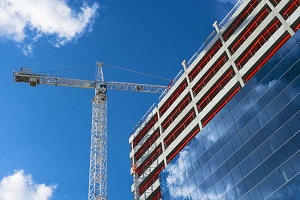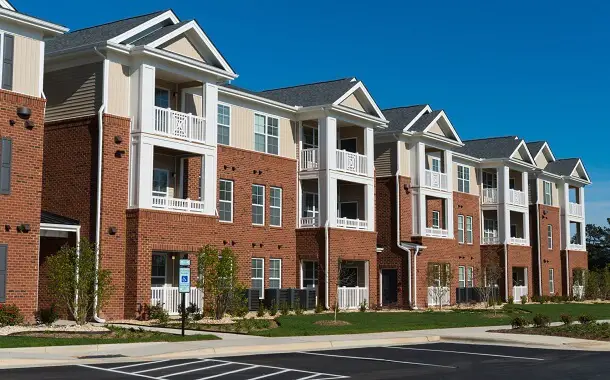How Much Does it Cost to Build an Apartment Complex?
More and more people are moving to cities, needing places to live. Housing demand is growing, with apartments being a popular option. Maybe you’ve thought about investing in some rental properties. Going from a small duplex to a bigger multi-family housing project can have good returns if done right. But starting that kind of large development can feel confusing. What will be the final cost to construct a full apartment complex? Let’s break it down.
How Much Does it Cost to Build an Apartment Complex?
The average cost to build an apartment complex will vary greatly from around $4.7 million on the low end to $52 million on the very high side. Of course, not all apartment buildings cost the same to construct. It’s impossible to put one price tag on every new complex.
The average for a typical 5-story, 50-unit mid-rise apartment building runs about $11 million.
Smaller buildings like basic duplexes average around $950,000. Luxury high-rise developments can run over $100 million.
Average construction costs are:
- Low-rise buildings – $150-$240 per square foot
Mid-rise buildings – $185-$270 per square foot
High-rise buildings – $235-$450+ per square foot
Another way to look at it is the cost per apartment unit. The average cost to build an apartment complex in this case is $65,000 – $86,000 per unit. But that doesn’t include any work site improvements or labor.
Levelset notes that across the nation, the average cost per square foot to build an apartment complex is $398.
According to Multifamily Loans, the cost of building an apartment complex is estimated to be around $12,250,000, with a cost per unit of $245,000. The same website claims that this construction project is pretty expensive to build, having an average construction cost of $350 per square foot as of 2023.
What Makes Up The Final Building Cost
Many factors affect the final cost of building an apartment complex. Size, location, permits – it all impacts price. Let’s explore the 6 main pieces that make up construction costs.
You might also like our articles about the cost of building a bridge, a hotel, or a castle.
Location
Desirable areas cost more to buy into. So building new housing in hot neighborhoods costs more too.
And different whole cities have varied general costs of living. Constructing in NYC will be really expensive. Building in Oklahoma City will be much more affordable.
Number of Apartment Units
We shared earlier the average building expense per apartment unit. It’s simple – more units equals a higher total construction cost. An 18-unit low-rise complex costs way less than a 200-unit high-rise tower.
And due to earthquake/wind resistance, every 10 stories extra on a high-rise also raises the price tag. Yes, bigger buildings with more units cost more upfront. But they also can produce higher profits from rent long-term.
Affordable vs Luxury Apartments
You can aim to construct affordable housing apartments or luxury buildings – or something in between. Surprisingly, base construction costs are pretty similar either way. The difference comes mostly from extra “luxury” features and amenities offered.
Affordable housing units have income-based lower rents. Some cities actually encourage or require private developers to include a number of below-market-rate units in certain neighborhoods. Building dedicated affordable housing also often comes with helpful tax perks.
Your Architect and Contractor Team
 To build well, you need to work with both an architect and a general contractor. Plus interior designers, plumbers, electricians, and more. Since labor makes up a chunk of the total cost, you want experts on your team.
To build well, you need to work with both an architect and a general contractor. Plus interior designers, plumbers, electricians, and more. Since labor makes up a chunk of the total cost, you want experts on your team.
Architects design the building itself plus all unit floor plans. They work on the overall look, required materials, fixtures, and systems like plumbing and electric. Along with contractors, they make sure proper permits are obtained.
Contractors then provide all actual construction services and materials. They hire needed subcontractors, give feedback to architects, get final permits, and clean up the finished site.
Unit Furnishings
Even “unfurnished” rental units need a decent base level of furnishings built-in. This includes stuff like:
- Bath fixtures
- Appliances (stove, refrigerator, etc.)
- Cabinets
- Doors and flooring
- Heating/cooling systems
- Lighting fixtures
- Paint, insulation
- Plumbing setups
- Windows
Paying for all required utilities, fixtures, and amenities – adds up. But it’s needed to make livable units.
Building Permits
Ideally, you can buy permitted land ready to build housing on. If not permitted yet for apartments, you’ll have to secure proper zoning permits first. Sometimes not too difficult, sometimes more challenging.
Research permit needs for multi-family buildings in your chosen area before purchasing any property. Permit costs are small compared to the whole project. But still a necessary step, so account for them in planning.
Additional Construction Cost Considerations
On top of the main apartment complex, look at expenses like:
- Clubhouse – A stand-alone community building for renters adds functional space.
- Outdoor Amenities – Features like pools, fitness zones, and dog parks may boost rents.
- Parking Structures – Beyond surface lots, garages or carports meet tenant parking needs.
- Retail Space – Mixed-use aspects with shops or eateries complement apartments.
- Infrastructure – Utilities, roads, and water management systems serve the site.
- Furnishings – Even “unfurnished” units need basic appliances, flooring, and cabinetry.
- Soft Costs – Survey fees, insurance, and interest payments must be budgeted as well.
While not mandatory, elements like these enrich the rental experience. Carefully weigh the costs versus the value added for your target demographic.
Strategies to Reduce Apartment Construction Costs
Just because you want a 100-unit luxury complex doesn’t mean you must overspend. Consider these tips to minimize expenses:
- Buy existing building land already zoned and permitted for multifamily use rather than undeveloped acreage.
- Research local utility hook-up fees, taxes, and construction labor wages based on the area.
- Partner with an experienced general contractor with trusted subcontractor relationships to reduce risk.
- Look at prefabricated building solutions to streamline on-site construction schedules.
- Evaluate off-site versus on-site parking decisions to reduce paved surfaces.
- Install mid-grade appliances or lighting packages instead of excessive high-end luxury finishes.
- Phase build-outs by completing floor-by-floor or section-by-section over time as leasing goals are met.
- Secure private financing partnerships or affordable housing tax credits to access preferred project funding.
The Outlook for Apartment Construction
Well-positioned multi-unit rental housing tied to realistic construction budgets continues to offer healthy investor returns. As more people migrate to metro regions, demand increases for reasonably priced apartments in good locations.
Building costs influence bottom lines so advanced planning is key. But with strategic development, owning rental real estate can prove quite profitable over the long run.
Final Words on the Construction Industry
Adding up the base construction, labor, location factors, furnishings, and permits gives your total project cost. With some smart design decisions and contractor partnerships, you can construct wonderful, profitable new apartments.


Leave a Reply
Want to join the discussion?Feel free to contribute!